A Study on Water Rights Allocation in Transboundary Rivers Based on the Transfer and Inequality Index of Virtual Water
Abstract
:1. Introduction
2. Methodology and Data Collection
2.1. Methodologies
2.1.1. Modelling of Physical Water Rights Allocation
Constructing an Index System of Physical Water Rights Allocation
Allocating Physical Water Rights
- (1)
- Decision making matrix
- (2)
- Data normalization
- (3)
- Project indicator function
- (4)
- Water rights allocation scheme
2.1.2. Model for Calculating VWT and VWI
2.1.2.1. Provincial VWT Calculation
VWI
- (1)
- Model of provincial TiVA transfer
- (2)
- Model of Inequality Index
2.1.3. Coupling of Physical and Virtual Water
Regional VWT
Model Integrated with Virtual Water
2.2. Data Collection
2.2.1. Study Area
2.2.2. Data Sources
3. Result
3.1. Physical Water Allocation
3.1.1. Characteristic Value of Indicators
3.1.2. Normalization
3.1.3. Indicator Weight
3.1.4. Physical Water Allocation
3.2. VWT among Regions in Taihu Lake Basin
3.2.1. Provincial VWT Calculation
3.2.2. VWI
3.3. The Water Allocation Coupling Physical and Virtual Water Resources
4. Discussion
4.1. Physical Water Allocation
4.2. VWT
5. Conclusions
- (1)
- Jiangsu enjoys the most allocated water, followed by Zhejiang, Shanghai, and then Anhui.
- (2)
- Anhui and Jiangsu are net exporters of virtual water (Anhui > Jiangsu), whereas Zhejiang and Shanghai are net importers (Zhejiang > Shanghai).
- (3)
- Anhui suffers the highest inequality, while Zhejiang boasts the most equal environment where economic benefit and environment are most matched.
- (4)
- VWT and VWI exert an impact on the water rights allocation of the four regions. Anhui in particular experiences the largest growth in allocated water rights due to the dual effects from VWT and VWI.
- (5)
- Anhui and Jiangsu are net exporters of virtual water, indicating that the two regions need economic structure reshaping more urgently.
Author Contributions
Funding
Data Availability Statement
Acknowledgments
Conflicts of Interest
Appendix A
| Output | Intermediate Use | Final Demand | Total Output | |||||||||
|---|---|---|---|---|---|---|---|---|---|---|---|---|
| Basin Province 1 | Basin Province (n) | Basin Province (n + 1) | Basin Province 1 | Basin Province n | Other Province (n + 1) | |||||||
| Input | Industry 1 | Industry m | Industry 1 | Industry m | Industry 1 | Industry m | ||||||
| Intermediate use | Basin province 1 | Industry 1 | ||||||||||
| Industry m | ||||||||||||
| Basin province n | Industry 1 | |||||||||||
| Industry m | ||||||||||||
| Other province (n + 1) | Industry 1 | |||||||||||
| Industry m | ||||||||||||
| Added value | ||||||||||||
| Total input | ||||||||||||
| Direct water input | ||||||||||||
References
- Zuo, Q.T.; Zhang, Z.Z.; Ma, J.X. The relationship between the utilization level of water resources in the Yellow River Basin and economic and social development China Population. Resour. Environ. 2021, 31, 10. [Google Scholar]
- Straffin, P.D.; Heaney, J.P. Game theory and the tennessee valley authority. Int. J. Game Theory 1981, 10, 35–43. [Google Scholar] [CrossRef]
- Connell, D.; Grafton, R.Q. Water reform in the Murray-Darling Basin. Water Resour. Res. 2011, 47, 1–9. [Google Scholar] [CrossRef] [Green Version]
- Genova, P.; Wei, Y. A socio-hydrological model for assessing water resource allocation and water environmental regulations in the Maipo River basin. J. Hydrol. 2023, 617, 129159. [Google Scholar] [CrossRef]
- Hu, J.L.; Ge, Y.X. The allocation mode and coordination mechanism of water resources in the Yellow River—Also on the construction and management of the Yellow River water rights market. Manag. World 2004, 8, 43–60. [Google Scholar]
- Feng, J. Optimal allocation of regional water resources based on multi-objective dynamic equilibrium strategy. Appl. Math. Model. 2021, 90, 1183–1203. [Google Scholar] [CrossRef]
- Wu, D.; Liu, M.G. Research progress on initial water rights allocation methods in river basins. People’s Pearl River 2022, 43, 7. [Google Scholar]
- Ge, M.; Wu, F.P.; You, M. Initial provincial water rights dynamic projection pursuit allocation based on the most stringent water resources management: A case study of Taihu Basin, China. Water 2017, 9, 35. [Google Scholar] [CrossRef] [Green Version]
- Wu, D.; Wu, F.P.; Chen, Y.P. A Double Layer Optimization Model for the Composite System of Initial Water Rights Allocation in a Basin. Syst. Eng. Theory Pract. 2012, 32, 196–202. [Google Scholar]
- Van Campenhout, B.; D’Exelle, B.; Lecoutere, E. Equity–efficiency optimizing resource allocation: The role of time preferences in a repeated irrigation game. Oxf. Bull. Econ. Stat. 2015, 77, 234–253. [Google Scholar] [CrossRef] [Green Version]
- Wang, L.; Fang, L.; Hipel, K.W. Basin-wide cooperative water resources allocation. Eur. J. Oper. Res. 2008, 190, 798–817. [Google Scholar] [CrossRef]
- Zhang, W.; Wang, Y.; Peng, H.; Li, Y.; Tang, J.; Wu, K.B. A coupled water quantity–quality model for water allocation analysis. Water Resour. Manag. 2010, 24, 485–511. [Google Scholar] [CrossRef]
- Read, L.; Madani, K.; Inanloo, B. Optimality versus stability in water resource allocation. J. Environ. Manag. 2014, 133, 343–354. [Google Scholar] [CrossRef]
- Zeng, X.T.; Li, Y.P.; Huang, G.H.; Liu, J. Modeling of water resources allocation and water quality management for supporting regional sustainability under uncertainty in an arid region. Water Resour. Manag. 2017, 31, 3699–3721. [Google Scholar] [CrossRef]
- Wu, D.; Wang, Y.H. A Multilayer Hierarchical Decision Model for Initial Water Rights Allocation in Watersheds under Dual Control Action. China Popul. Resour. Environ. 2017, 27, 10. [Google Scholar]
- Milly, P.C.D.; Betancourt, J.; Falkenmark, M.; Hirsch, R.M.; Kundzewicz, Z.W.; Lettenmaier, D.P.; Stouffer, R.J. Stationarity is dead: Whither water management? Science 2008, 319, 573–574. [Google Scholar] [CrossRef]
- Null, S.E.; Prudencio, L. Climate change effects on water allocations with season dependent water rights. Sci. Total Environ. 2016, 571, 943–954. [Google Scholar] [CrossRef] [Green Version]
- Dau, Q.V.; Momblanch, A.; Adeloye, A.J. Adaptation by himalayan water resource system under a sustainable socioeconomic pathway in a high-emission context. J. Hydrol. Eng. 2021, 26, 50–55. [Google Scholar] [CrossRef]
- Zhang, L.N.; Wu, F.P. A study on the coupling configuration model of quantity and quality of initial water rights in provinces and regions based on GSR theory. Resour. Sci. 2017, 39, 12. [Google Scholar]
- Wang, H.M.; Yu, R.; Niu, W.J. Design of Water Quantity Coordination Scheme for Cross boundary Water Resources Conflict in the Zhanghe River Basin Based on Strong Reciprocity. Theory Syst. Eng. Theory Pract. 2014, 34, 2170–2178. [Google Scholar]
- Lou, S.; Wang, H.M.; Niu, W.J.; Xu, Y. Research on group decision-making of water resource allocation based on interval intuitionistic fuzzy sets. Resour. Environ. Yangtze River Basin 2014, 23, 9. [Google Scholar]
- Xevi, E.; Khan, S. A multi-objective optimisation approach to water management. J. Environ. Manag. 2005, 77, 269–277. [Google Scholar] [CrossRef] [PubMed]
- Hong, S.; Xia, J.; Chen, J.; Wan, L.; Ning, L.; Shi, W. Multi-object approach and its application to adaptive water management under climate change. J. Geogr. Sci. 2017, 27, 259–274. [Google Scholar] [CrossRef]
- Dadmand, F.; Naji-Azimi, Z.; Farimani, N.M.; Davary, K. Sustainable allocation of water resources in water-scarcity conditions using robust fuzzy stochastic programming. J. Clean. Prod. 2020, 276, 123812. [Google Scholar] [CrossRef]
- Allan, J.A. Virtual water: A strategic resource global solutions to regional deficits. Ground Water 1998, 36, 545–546. [Google Scholar] [CrossRef]
- Ye, Q.; Li, Y.; Zhuo, L.; Zhang, W.; Xiong, W.; Wang, C.; Wang, P. Optimal allocation of physical water resources integrated with virtual water trade in water scarce regions: A case study for Beijing, China. Water Res. 2018, 129, 264–276. [Google Scholar] [CrossRef]
- Duarte, R.; Pinilla, V.; Serrano, A. The water footprint of the Spanish agricultural sector: 1860–2010. Ecol. Econ. 2014, 108, 200–207. [Google Scholar] [CrossRef]
- Brindha, K. International virtual water flows from agricultural and livestock products of India. J. Clean. Prod. 2017, 161, 922–930. [Google Scholar] [CrossRef]
- Hoekstra, A.Y.; Mekonnen, M.M. Imported water risk: The case of the UK. Environ. Res. Lett. 2016, 11, 055002. [Google Scholar] [CrossRef]
- Wang, R.; Zimmerman, J. Hybrid analysis of blue water consumption and water scarcity implications at the global, national, and basin levels in an increasingly globalized world. Environ. Sci. Technol. 2016, 50, 5143–5153. [Google Scholar] [CrossRef]
- Weinzettel, J.; Pfister, S. International trade of global scarce water use in agriculture: Modeling on watershed level with monthly resolution. Ecol. Econ. 2019, 159, 301–311. [Google Scholar] [CrossRef]
- Zhao, X.; Liu, J.; Liu, Q.; Tillotson, M.R.; Guan, D.; Hubacek, K. Physical and virtual water transfers for regional water stress alleviation in China. Proc. Natl. Acad. Sci. USA 2015, 112, 1031–1035. [Google Scholar] [CrossRef] [PubMed] [Green Version]
- Zhao, Y.; He, G.; Wang, J.; Gao, X.; Li, H.; Zhu, Y.; Jiang, S. Water stress assessment integrated with virtual water trade and physical transfer water: A case study of Beijing, China. Sci. Total Environ. 2020, 708, 431–478. [Google Scholar] [CrossRef] [PubMed]
- Zhao, H.; Qu, S.; Guo, S.; Zhao, H.; Liang, S.; Xu, M. Virtual water scarcity risk to global trade under climate change. J. Clean. Prod. 2019, 230, 1013–1026. [Google Scholar] [CrossRef]
- Xu, C.X.; Ma, C.; Tian, G.L.; Xie, W. Research on the Mechanism and Contribution Share of Virtual Water Trade on Regional Economy. China Soft Sci. 2011, 12, 110–119. [Google Scholar]
- Islam, M.S.; Oki, T.; Kanae, S.; Hanasaki, N.; Agata, Y.; Yoshimura, K. A grid-based assessment of global water scarcity including virtual water trading. Water Resour. Manag. 2007, 21, 19–37. [Google Scholar] [CrossRef]
- Brindha, K. National water saving through import of agriculture and livestock products: A case study from India. Sustain. Prod. Consum. 2019, 18, 63–71. [Google Scholar] [CrossRef]
- Yu, C.; Yue, D.M.; Gong, M.D.; Wang, L.; Cheng, B. Log water footprint accounting and spatial flow pattern of countries along the “the Belt and Road”. For. Econ. 2021, 42, 16–27. [Google Scholar]
- Angelis, E.; Metulini, R.; Bove, V.; Riccaboni, M. Virtual water trade and bilateral conflicts. Adv. Water Resour. 2017, 110, 549–561. [Google Scholar] [CrossRef] [Green Version]
- Tian, G.L.; Wang, X.W. A study on the virtual water flow relationship between China and countries along the Mekong River driven by agricultural trade. J. North China Univ. Water Resour. Hydropower 2018, 39, 16–23. [Google Scholar]
- Wu, P.; Gao, X.R.; Zhao, X.N.; Wang, Y.B.; Sun, S.K. Basic framework of “two-dimensional and three-dimensional” coupled flow theory of solid water virtual water. J. Agric. Eng. 2016, 32, 1–10. [Google Scholar]
- Heil, M.T.; Wodon, Q.T. Inequality in CO2 emissions between poor and rich countries. J. Environ. Dev. 1997, 6, 426–452. [Google Scholar] [CrossRef]
- Yang, T.; Liu, W. Inequality of household carbon emissions and its influencing factors: Case study of urban China. Habitat Int. 2017, 70, 61–71. [Google Scholar] [CrossRef]
- Hedenus, F.; Azar, C. Estimates of trends in global income and resource inequalities. Ecol. Econ. 2006, 55, 351–364. [Google Scholar] [CrossRef]
- Padilla, E.; Serrano, A. Inequality in CO2 emissions across countries and its relationship with income inequality: A distributive approach-science direct. Energy Policy 2006, 34, 1762–1772. [Google Scholar] [CrossRef] [Green Version]
- Wang, D.; Nie, R.; Wang, S.Z. Measurement and Decomposition of Regional Inequality in Carbon Dioxide Emissions in China: From the Perspective of Interpersonal Equity. Sci. Res. 2012, 30, 1662–1670. [Google Scholar]
- Shang, H.Y. Comparison of methods for measuring the unfairness of virtual water consumption. Rural. Water Resour. Hydropower China 2011, 5, 1–5. [Google Scholar]
- Wang, H.H.; Liu, H.C.; He, X.J.; Zeng, W. Research on Carbon Emission Fairness from the Perspective of Historical Accumulated Carbon Emissions. China Popul. Resour. Environ. 2016, 26, 22–25. [Google Scholar]
- Sun, H.; Liu, Y.Y. Analysis of Interregional Carbon Emission Differences and Profit and Loss Deviation in China. Manag. Rev. 2016, 28, 89–96. [Google Scholar]
- Yan, M.; Sun, H.A. Study on the Implied Carbon Transfer and Profit and Loss Deviation in Domestic Trade: Based on the Perspective of Economic Internal Circulation. Technol. Econ. Manag. Res. 2021, 12, 12–16. [Google Scholar]
- Zhang, W.; Liu, Y.; Feng, K.; Hubacek, K.; Wang, J.; Liu, M.-M.; Jiang, L.; Jiang, H.; Liu, N.; Zhang, P.; et al. Revealing environmental inequality hidden in China’s inter-regional trade. Environ. Sci. Technol. 2018, 52, 7171–7181. [Google Scholar] [CrossRef]
- Leontief, W. Environmental repercussions and the economic structure: An input-output approach. Rev. Econ. Stat. 1970, 52, 262–271. [Google Scholar] [CrossRef]
- Chapagain, A.K.; Hoekstra, A.Y. Virtual Water Flows between Nations in Relation to Trade in Livestock and Livestock Products; UNESCO-IHE: Delft, The Netherlands, 2003. [Google Scholar]
- Antonelli, M.; Roson, R.; Sartori, M. Systemic input-output computation of green and blue virtual water ‘flows’ with an illustration for the Mediterranean region. Water Resour. Manag. 2012, 26, 4133–4146. [Google Scholar] [CrossRef]
- Deng, G.; Lu, F.; Wu, L.; Xu, C. Social network analysis of virtual water trade among major countries in the world. Sci. Total Environ. 2021, 753, 142043. [Google Scholar] [CrossRef]
- Zhu, Q.R.; Yang, L.; Liu, X. Research on water footprint of China’s export trade and trade structure optimization. Quant. Econ. Technol. Econ. Res. 2016, 12, 42–60. [Google Scholar]
- Dietzenbacher, E.; Velazquez, E. Analysing Andalusian virtual water trade in an Input-Output Framework. Reg. Stud. 2007, 41, 185–196. [Google Scholar] [CrossRef] [Green Version]
- Lutter, S.; Pfister, S.; Giljum, S.; Wieland, H.; Mutel, C. Spatially explicit assessment of water embodied in European trade: A product-level multi-regional input-output analysis. Glob. Environ. Chang. 2016, 38, 171–182. [Google Scholar] [CrossRef] [Green Version]
- Chen, Z.M.; Chen, G.Q. Virtual water accounting for the globalized world economy: National water footprint and international virtual water trade. Ecol. Indic. 2013, 28, 142–149. [Google Scholar] [CrossRef]
- Xu, X.; Wu, F.; Yu, Q.; Chen, X.; Zhao, Y. Invisible Effect of Virtual Water Transfer on Water Quantity Conflict in Transboundary Rivers—Taking Ili River as a Case. Int. J. Environ. Res. Public Health 2022, 19, 8917. [Google Scholar] [CrossRef]
- Xu, X.; Wu, F.; Yu, Q.; Chen, X.; Zhao, Y. Analysis on Management Policies on Water Quantity Conflict in Transboundary Rivers Embedded with Virtual Water—Using Ili River as the Case. Sustainability 2022, 14, 9406. [Google Scholar] [CrossRef]
- Bureau of Taihu Lake Basin. Available online: http://www.tba.gov.cn/slbthlyglj/sj/sj.html (accessed on 10 April 2023).
- Carbon Emission Accounts & Datasets. Available online: https://www.ceads.net/user/login.php?lang=cn (accessed on 10 March 2023).
- China Statistical Yearbook. Available online: http://www.stats.gov.cn/sj/ndsj/2017/indexch.htm (accessed on 10 April 2023).
- Anhui Provincial Department of Water Resources. Available online: http://slt.ah.gov.cn/tsdw/swj/szyshjjcypj/119406621.html (accessed on 10 March 2023).
- Jiangsu Provincial Department of Water Resources. Available online: http://jssslt.jiangsu.gov.cn/art/2018/7/31/art_84437_10430538.html (accessed on 10 March 2023).
- Zhejiang Provincial Department of Water Resources. Available online: http://slt.zj.gov.cn/col/col1229243017/index.html (accessed on 10 March 2023).
- Shanghai Municipal Water Affairs Bureau. Available online: http://swj.sh.gov.cn/szy/20200910/138eca2189d24dfda9e6f2b40a24797a.html (accessed on 10 March 2023).
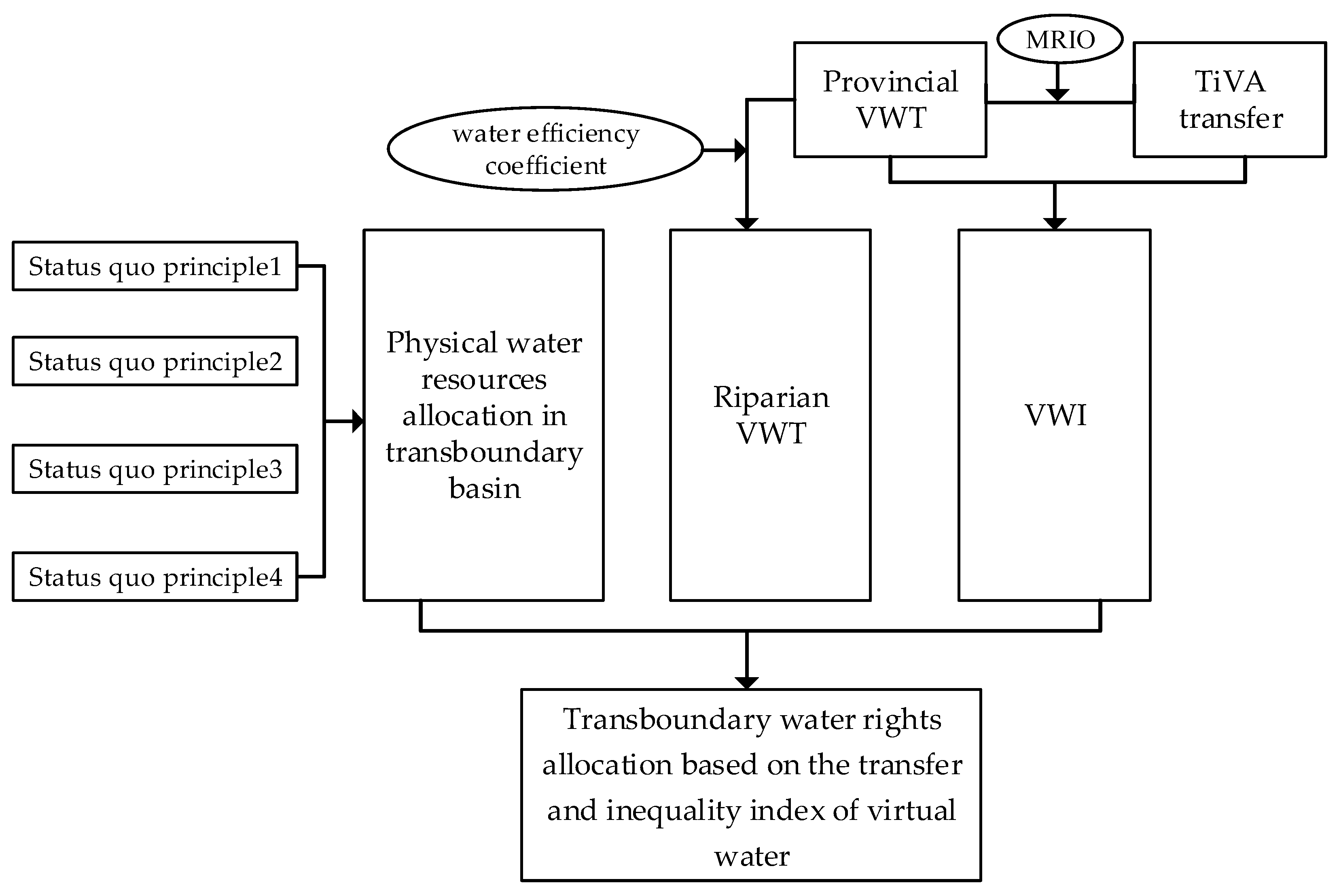
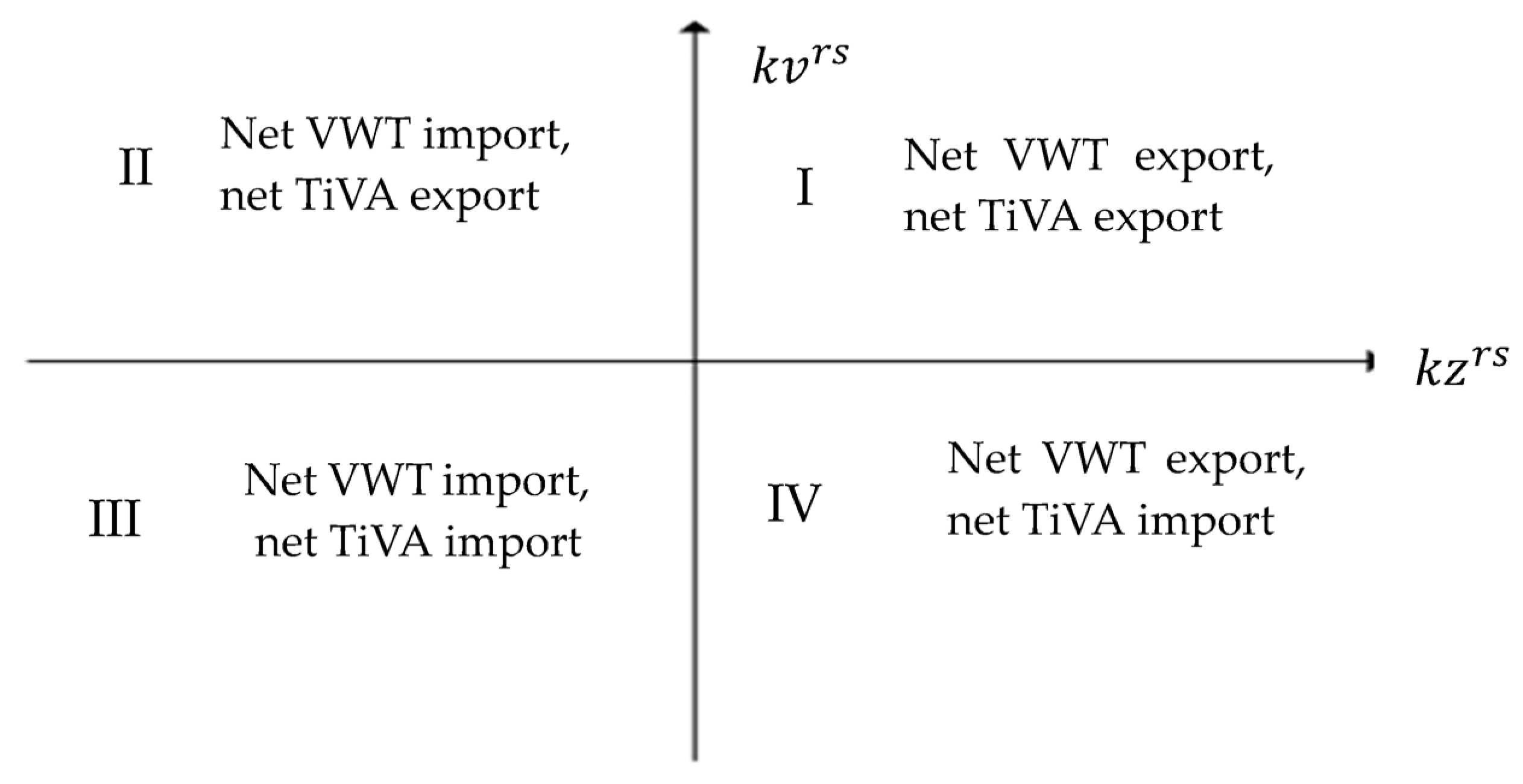
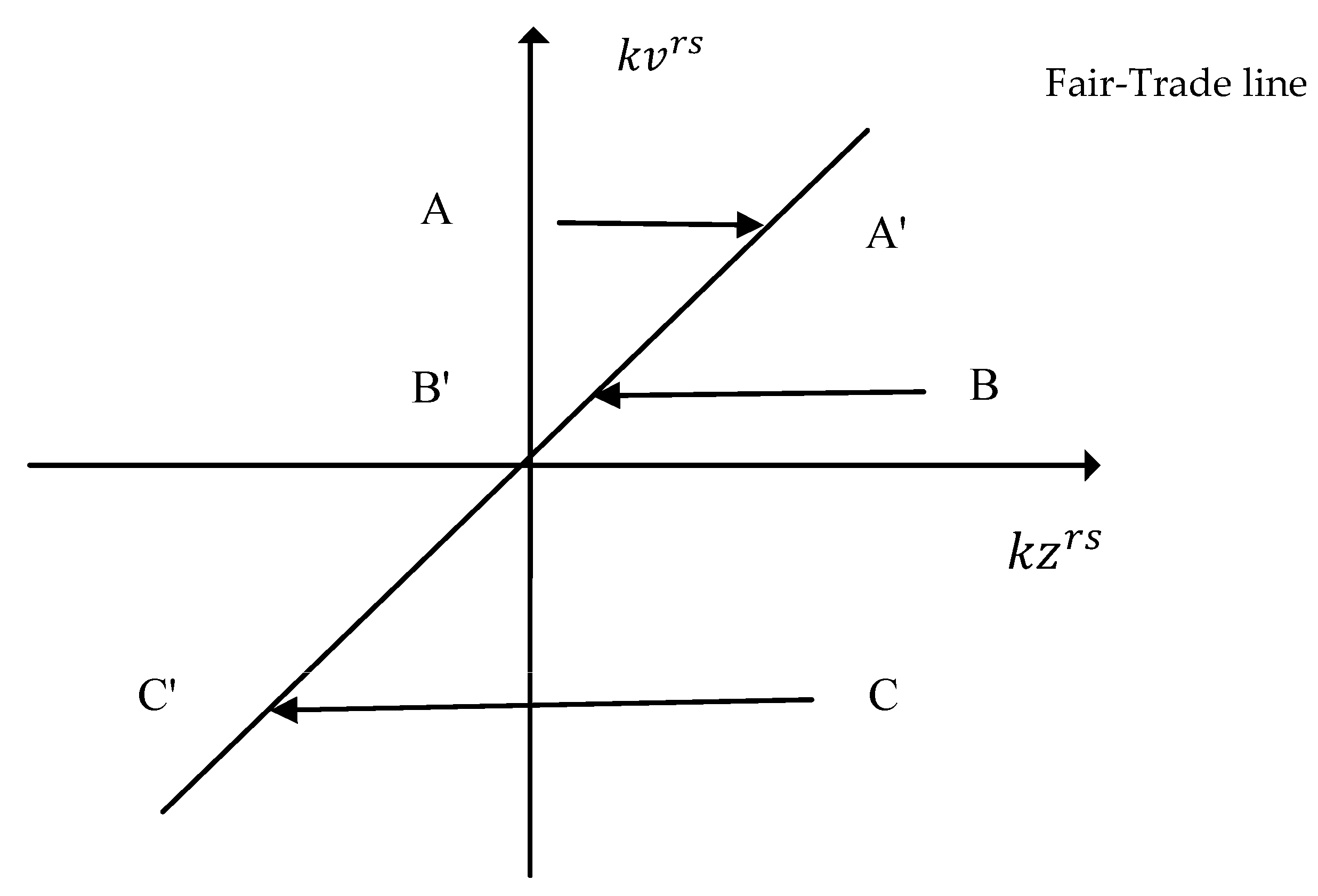



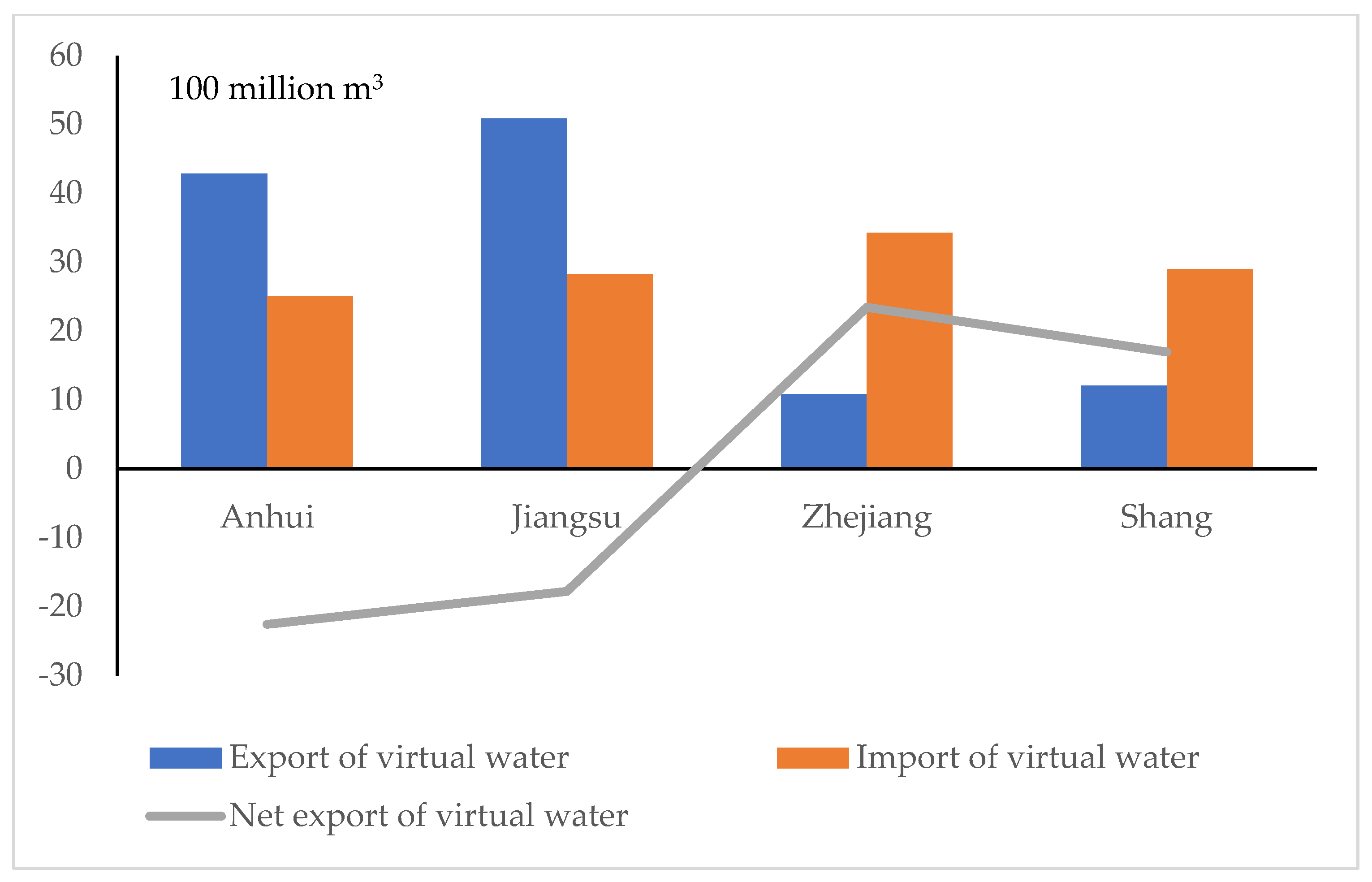
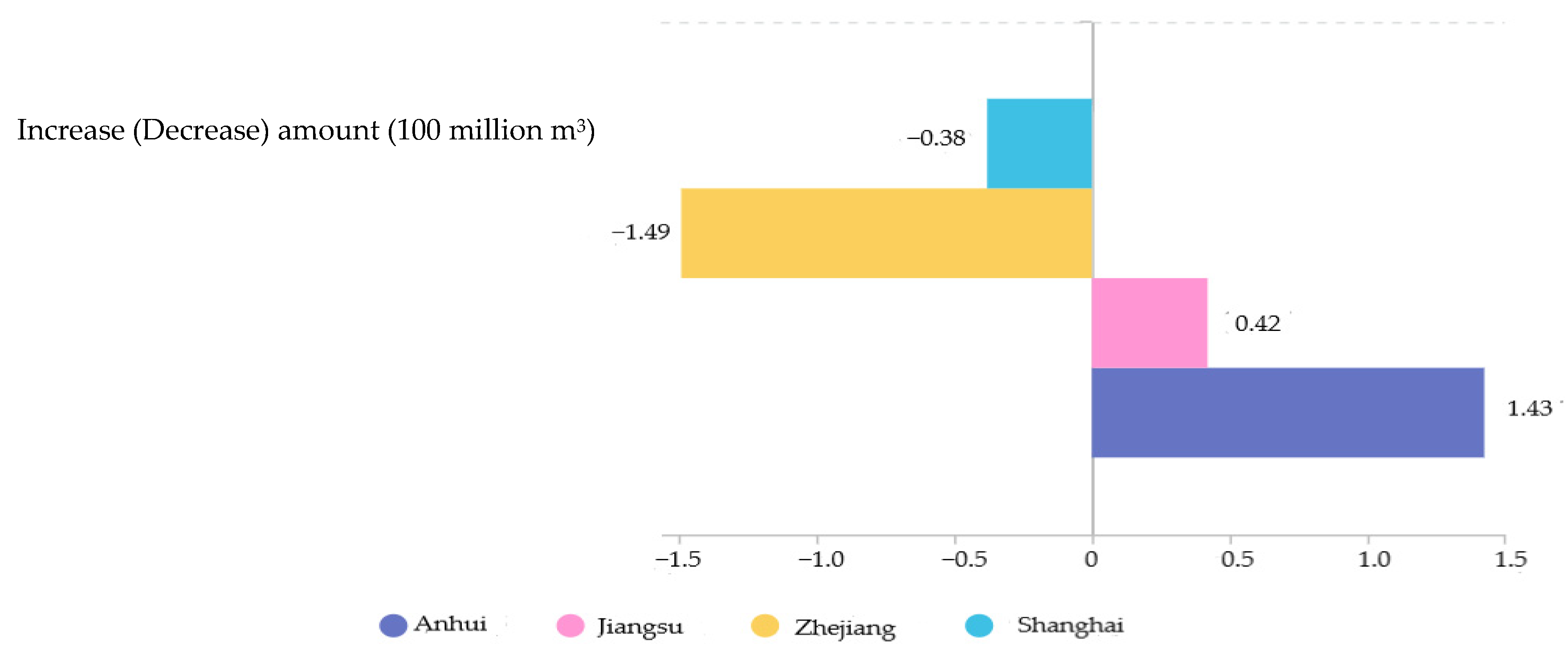
| Scheme | Principle | Indicator | Units | Symbol | Attribute |
|---|---|---|---|---|---|
| Physical water rights allocation scheme A | Status quo B1 | Current water use | Billion m3 | P11 | Benefit-based |
| Water use per capita | m3/person | P12 | Benefit-based | ||
| Water use per farmland unit | m3/mu | P13 | Benefit-based | ||
| Current water supply scale | 10,000 m3 | P14 | Benefit-based | ||
| Equity B2 | Annual average runoff volume | Billion m3 | P21 | Benefit-based | |
| Population | 10,000 people | P22 | Benefit-based | ||
| Effective Irrigated area | m3 | P23 | Benefit-based | ||
| Efficiency B3 | GDP per capita | 10,000 yuan | P31 | Benefit-based | |
| Industrial output per capita | 10,000 yuan | P32 | Benefit-based | ||
| Agricultural output per capita | 10,000 yuan | P33 | Benefit-based | ||
| Water consumption per 10,000 yuan GDP | m3 | P34 | Cost-based | ||
| Water consumption per 10,000 yuan agricultural output | m3 | P35 | Cost-based | ||
| Water consumption per 10,000 yuan industrial output | m3 | P36 | Cost-based | ||
| Sustainability B4 | Economic growth rate | % | P41 | Benefit-based | |
| Greening rate | % | P42 | Benefit-based | ||
| Population growth rate | % | P43 | Benefit-based | ||
| Proportion of waste water meeting discharge standards | % | P44 | Benefit-based | ||
| Macro regulation B5 | Priority of regional development | points | P51 | Benefit-based | |
| Protection of vulnerable groups | points | P52 | Benefit-based |
| Water Use | Domestic Water | Industrial Water | Total Water Consumption | |
|---|---|---|---|---|
| Region | ||||
| Anhui | 0.002 | 0.016 | 0.018 | |
| Jiangsu | 1.59 | 18.27 | 20.02 | |
| Zhejiang | 0.77 | 3.43 | 4.32 | |
| Shanghai | 1.37 | 8.42 | 9.87 | |
| Indicator | Anhui N1 | Jiangsu N2 | Zhejiang N3 | Shanghai N4 |
|---|---|---|---|---|
| P11 | 0.24 | 195 | 47.1 | 98.2 |
| P12 | 503 | 802 | 370 | 418 |
| P13 | 331 | 446 | 381 | 524 |
| P14 | 1.3 | 94.6 | 82.6 | 28.4 |
| P21 | 0.12 | 10.68 | 6.66 | 2.84 |
| P22 | 36.35 | 3186.51 | 1987.02 | 848.12 |
| P23 | 11.75 | 1030.43 | 642.55 | 274.26 |
| P31 | 2.8 | 7.02 | 13.6 | 18.6 |
| P32 | 1.91 | 4.81 | 7.97 | 9.82 |
| P33 | 0.37 | 0.45 | 0.24 | 0.06 |
| P34 | 214 | 52 | 35 | 33 |
| P35 | 1.85 | 0.011 | 0.01 | 0.0052 |
| P36 | 72 | 82 | 21 | 75 |
| P41 | 8.5 | 7.2 | 7.8 | 6.9 |
| P42 | 0.082 | 0.028 | 0.06 | 0.028 |
| P43 | 58.03 | 39.84 | 37.8 | 30 |
| P44 | 58.3 | 60.4 | 57.2 | 70.53 |
| P51 | 6 | 8 | 8 | 7 |
| P52 | 7 | 6 | 6 | 6 |
| Bi | |||
|---|---|---|---|
| A | B1 | P11 | 0.1472 |
| P12 | 0.0503 | ||
| P13 | 0.0503 | ||
| P14 | 0.0172 | ||
| B2 | P21 | 0.0983 | |
| P22 | 0.1967 | ||
| P23 | 0.1967 | ||
| B3 | P31 | 0.0272 | |
| P32 | 0.0272 | ||
| P33 | 0.0272 | ||
| P34 | 0.0136 | ||
| P35 | 0.0272 | ||
| P36 | 0.0136 | ||
| B4 | P41 | 0.0363 | |
| P42 | 0.0140 | ||
| P43 | 0.0140 | ||
| P44 | 0.0054 | ||
| B5 | P51 | 0.0251 | |
| P52 | 0.0125 |
| Region | Quantity (Billion m3) | ||||
|---|---|---|---|---|---|
| Anhui | 0.8659 | 0.0992 | 0.1028 | 5.51% | 1.683 |
| Jiangsu | 0.1070 | 0.8233 | 0.8850 | 47.50% | 14.491 |
| Zhejiang | 0.2810 | 0.3444 | 0.5507 | 29.56% | 9.018 |
| Shanghai | 0.4767 | 0.2293 | 0.3248 | 17.43% | 6.318 |
| Region | |||
|---|---|---|---|
| Anhui | 0.4401 | 0.1957 | 0.0543 |
| Jiangsu | 0.5076 | 0.2257 | 0.0243 |
| Zhejiang | 0.7012 | 0.3118 | −0.0618 |
| Shanghai | 0.5999 | 0.2668 | −0.0168 |
| Region | (Billion m3) | Quantity (Billion m3) | ||
|---|---|---|---|---|
| Anhui | 2.259 | 1.17 | 5.73% | 1.827 |
| Jiangsu | 1.780 | 0.96 | 45.58% | 14.533 |
| Zhejiang | −2.344 | 1.03 | 28.15% | 8.869 |
| Shanghai | −1.695 | 1.34 | 19.93% | 6.280 |
| Region | Anhui | Jiangsu | Zhejiang | Shanghai | Units | |
|---|---|---|---|---|---|---|
| Allocation Amount | ||||||
| Amount in this paper | 16.83 | 144.91 | 90.18 | 53.18 | 100 million m3 | |
| Amount in previous studies | 0 | 147.33 | 125.07 | 86.39 | 100 million m3 | |
| Proportion in this paper | 5.52 | 47.50 | 29.56 | 17.43 | % | |
| Proportion in previous studies | 0 | 41.06 | 34.86 | 24.08 | % | |
Disclaimer/Publisher’s Note: The statements, opinions and data contained in all publications are solely those of the individual author(s) and contributor(s) and not of MDPI and/or the editor(s). MDPI and/or the editor(s) disclaim responsibility for any injury to people or property resulting from any ideas, methods, instructions or products referred to in the content. |
© 2023 by the authors. Licensee MDPI, Basel, Switzerland. This article is an open access article distributed under the terms and conditions of the Creative Commons Attribution (CC BY) license (https://creativecommons.org/licenses/by/4.0/).
Share and Cite
Xu, X.; Yuan, J.; Yu, Q. A Study on Water Rights Allocation in Transboundary Rivers Based on the Transfer and Inequality Index of Virtual Water. Water 2023, 15, 2379. https://doi.org/10.3390/w15132379
Xu X, Yuan J, Yu Q. A Study on Water Rights Allocation in Transboundary Rivers Based on the Transfer and Inequality Index of Virtual Water. Water. 2023; 15(13):2379. https://doi.org/10.3390/w15132379
Chicago/Turabian StyleXu, Xia, Jing Yuan, and Qianwen Yu. 2023. "A Study on Water Rights Allocation in Transboundary Rivers Based on the Transfer and Inequality Index of Virtual Water" Water 15, no. 13: 2379. https://doi.org/10.3390/w15132379
APA StyleXu, X., Yuan, J., & Yu, Q. (2023). A Study on Water Rights Allocation in Transboundary Rivers Based on the Transfer and Inequality Index of Virtual Water. Water, 15(13), 2379. https://doi.org/10.3390/w15132379







